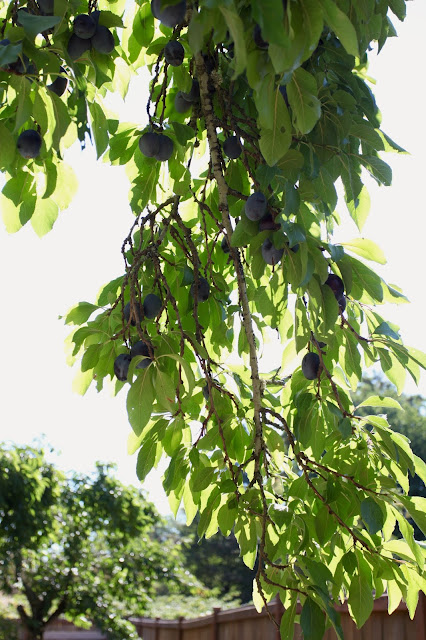I read an article about fermentation by Sandor Katz a while back and couldn't wait to order his book, The Art of Fermentation. It's basically an encyclopedia, huge and extensive, but encouraging. Katz presents fermentation as a natural and historical practice; one that does not have to be complicated or intimidating. This is exactly what I needed to read. My experience with fermentation, up to this point was home brewing beer with my ex, Preston, but it was mostly his thing. I just helped and enjoyed the product. I thought wine would be fun to make (er, should I say 'have and drink'), but the steps involved, the intricate recipes and supply lists were enough to scare me away.
That was until we moved into a house with fruit trees. There in our yard grows the main ingredient for so many yummy things, and my need to utilize what the earth gives without waste has won me over. My goal for the year was to begin some sorts of fermentation using our fruit supply. While searching the web for plum wine recipes I found one sourced from True Brews, by Emma Christensen. I ordered the book for myself and found it to be SO helpful in starting small and overcoming the fear or fermentation failure.
My first actual ferment was soda! Yep, bubbly, juicy soda carbonated with yeast. I tried all sorts of fruit mixtures and found that stronger, sweeter flavors mask the trace taste of yeast. Blackberry, blackberry plum, strawberry, and ginger were all successes.
Next up: Kombucha
A work friend gave me a split of her SCOBY and a cup of starter tea and off I went. It's a quick, two week process of brewing, fermenting, and bottling. I've been tinkering with flavors, my favorite so far being pineapple sage. It's a type of sage that tastes so much like pineapple you'd think the juice was added to the kombucha.
 |
| pineapple sage |
Third tackle: shrubs!
It's fruit-flavored drinking vinegar. Potent and syrupy, it flavors whatever you add it to - water, mixed drinks, white wine. I am making mine with our oh-so ample plums and blackberries. The lot behind ours is overrun with blackberries so I prop the ladder up to the fence and pluck away.
 |
| Fermentation pantry - Shrubs, kombucha in back, dry cider |
Project #4: Hard Apple Cider
In my last post I mentioned the mass picking and pressing. I made a batch of dry cider with the fresh, unpasteurized juice. That is currently sitting in jugs for its secondary fermentation (which will last two more weeks.) We did a four gallon batch of hard cider using juice I had pasteurized so we could take our time getting to the project. It's also in its secondary fermentation. We'll taste before bottling to see if it needs extra sugar, but our goal is a drier sparkling cider.
 |
| Left: 2 gallons (and taster bottle) of plum wine in secondary ferment Right: 4 gallons hard cider in secondary ferment |
The Big Show: PLUM WINE!
This is the baby we've been waiting for since we moved in to our house. We have to very large plum trees and right now we've got plums falling out our ears. After rinsing, halving, pitting and chopping the plums we add them to a bucket of sugar water. For sake of following a recipe (Again, I'm basing most of my homemade drinks on Emma Christensen's recipes in True Brews) we sanitized all the fruit.
Our large batches (a two gallon wine in secondary fermentation and a four gallon in primary fermentation) have been sanitized with Campden tablets to kill wild yeasts before adding a packaged yeast. We also add a yeast nutrient to keep it working, acid blend, pectic enzyme, and tannin. After a week of primary fermentation we were pleasantly surprised at the taste - like wine already!
 |
| A cup of wine with yeast bubbling in it - yeast starter for the batch |
 |
| Plum Wine, 24hrs after submerging the fruit and sanitizing. How RED! Ready to add yeast! |
For experimentation sake I set aside a small batch of plum wine to let ferment naturally - wild fermentation. I did not sanitize the fruit or add packaged yeast. The yeast from the fruit skin and the air will do the job for me. I've never tried anything like it, so I'm excited to see how it goes.
 |
| Bottle shelf with the wild fermenting plum wine. |
Fermentation is not a new concept - but its new for me, and now I see it everywhere. It's a cycle of earth and life that I'm learning with both my hands and my heart. It's a process of preparation and patience - learning how to let life work from within.
As I walk around our home I find so many forms of growth, fermentation, and culturing. It's a beautiful thing to feel everything around in seasonal motion.
 |
| Hops - maybe to add to cider later! |
 |
| Farm rows beneath burlap - soil development this season. |
 |
| Duck bedding is curing along with some coffee grinds. This will make rich compost and mulch. |
 |
| Rae's plantain infusion for medicinal salves. |
 |
| The lady fowls enrich their pond with pooh, which makes for great plant watering. |
 |
| The Yard Crew |
"Moving toward a more harmonious way of life and greater resilience requires our active participation. This means finding ways to become more aware of and connected to the other forms of life that are around us and that constitute our food - plants and animals, as well as bacteria and fungi - and to the resources, such as water, fuel, materials, tools and transportation, upon which we depend." -Sandor Katz




